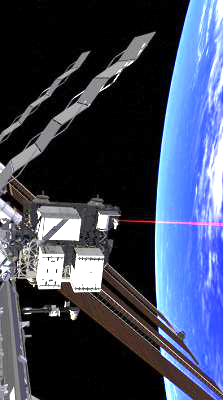Orbital 'Hello' marks start of laser communications
 Space communications have moved out of radio and into optical frequencies, with the launch of NASA’s latest technology.
Space communications have moved out of radio and into optical frequencies, with the launch of NASA’s latest technology.
A message has been sent from the International Space Station in the form of high-definition video beamed via laser from space to ground.
The 175-megabit video transmission was the first for the new Optical Payload for Lasercomm Science (OPALS).
The exciting laser communications advance could improve the way we receive data from orbit and beyond.
The emerging technology of laser-based optical communications - dubbed ‘lasercomm’ – has been likened to upgrading from dial-up to DSL.
OPALS was sent to the space station aboard the SpaceX Dragon some months ago, making this of the most significant efforts also for the private space industry.
NASA says the technological demonstration will push researchers into further explorations of high-bandwidth methods for communicating with future spacecraft.
Optical tools like OPALS use focused laser energy to achieve data rates 10 to 1,000 times higher than current space communications, which rely on radio portions of the electromagnetic spectrum.
An incredible amount of information transfer is required to use space-based rigs such as the Curiosity rover, and NASA says lasercomm and other advances will allow it to conduct even better experiments in deep space.
The space station moves through our sky at about 28,100 km/h. The incredible speed requires precise pointing ability, roughly equivalent to a person aiming a laser pointer at the end of a human hair ten metres away and keeping it there while walking.
To reach this precision, OPALS locked onto a ground beacon emitted by the Optical Communications Telescope Laboratory ground station at the Table Mountain Observatory in California.
Once locked onto the signal, OPALS began to modulate the beam from its 2.5-Watt 1,550-nanometer laser to transmit the video. The entire transmission lasted 148 seconds and achieved a maximum data rate of 50 megabits per second.
It took OPALS 3.5 seconds to transmit a single copy of a video message reading “Hello World!”, which would have taken more than 10 minutes using traditional methods. The message was sent multiple times during the transmission.
But this is not just for spaceships; NASA says the lasercomm tests prove the usefulness of the technology for optimised communications in general, and it may one day be used to greatly improve bandwidth in communications to and from satellites.








 Print
Print